Firefly Friday: Jim Raynor
Editor’s Note: Please welcome a new writer to our site, Jasmine! We’re kicking this series a day early this week due to the long weekend. Enjoy.
This is a brand new column, showcasing some of the amazing flexibility of the Firefly RPG, by Margaret Weis Productions. The game is amazing – even if you’re not familiar with the short-lived but popular show, do yourself a favor and check it out. The ins and outs will be very familiar to anyone who’s played Cortex Plus games before (which is to say, clean, narrative-driven, but also with a level of mechanical crunch that had my two system mastery players squealing), and it’s a strong introduction to Cortex Plus for anyone who hasn’t.
 What I’ll be doing each week is selecting a fictional character from settings which are not Firefly (the books take care of, oh, basically everyone from the show, plus dozens of ‘Verse folk who aren’t), and building them as a starting character in the system, rules as written. Today, I’ll be tackling someone from my second favorite cowboys-in-space setting, Starcraft – Jim Raynor, specifically from immediately before the first game. We’re not going too far afield yet – Jimmy would fit perfectly into any Firefly campaign without changing barely a thing. Don’t worry though, as we get deeper into this column, you’ll get to see just how far the system can bend without breaking.
What I’ll be doing each week is selecting a fictional character from settings which are not Firefly (the books take care of, oh, basically everyone from the show, plus dozens of ‘Verse folk who aren’t), and building them as a starting character in the system, rules as written. Today, I’ll be tackling someone from my second favorite cowboys-in-space setting, Starcraft – Jim Raynor, specifically from immediately before the first game. We’re not going too far afield yet – Jimmy would fit perfectly into any Firefly campaign without changing barely a thing. Don’t worry though, as we get deeper into this column, you’ll get to see just how far the system can bend without breaking.
The book goes through the character creation process step by step, but if this is your first exposure to this system that won’t help you much. So I’ll be sure to fill you in! Later articles are going to focus more on the way each character stretches the dials and switches to really embody a specific concept – for today though, Raynor’s a perfect example to explain the complete process with.
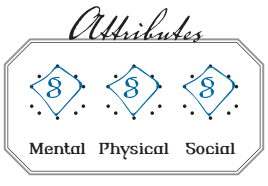 Starting with Attributes – with every character in Firefly, you’re going to have a proportional set between the traits Mental, Physical, and Social, averaging out to a d8. Every time you roll the dice, you include exactly one of these, as appropriate. When I’m here, I try to gauge whether the character should stand out definitively in one of the three (to get that d10), but if it turns out there’s not another Attribute I’m willing to sacrifice (down to d6) for it, it’s clear the character needs that balance of all d8 Attributes. Raynor’s no genius, but his military acumen is sharp. An impressive physical presence is toned down by years of drinking and battle scars. He’s rough around the edges, but also a respected leader.
Starting with Attributes – with every character in Firefly, you’re going to have a proportional set between the traits Mental, Physical, and Social, averaging out to a d8. Every time you roll the dice, you include exactly one of these, as appropriate. When I’m here, I try to gauge whether the character should stand out definitively in one of the three (to get that d10), but if it turns out there’s not another Attribute I’m willing to sacrifice (down to d6) for it, it’s clear the character needs that balance of all d8 Attributes. Raynor’s no genius, but his military acumen is sharp. An impressive physical presence is toned down by years of drinking and battle scars. He’s rough around the edges, but also a respected leader.
Distinctions are where the real magic happens in Firefly. Each one starts out as a simple phrase which tells your group about your character, but they’re so much more. They define major aspects about you, they inform your skill selection, and they’re the hook on which the system hangs your mechanical exceptions. Just like Attributes, whenever you roll the dice, you can include a Distinction – they’re a double-edged blade though. If your Distinction will benefit your action, take a solid d8 – but if it’s somehow holding you back, take a weaker d4 (but you get to bank a Plot Point for your trouble).
You get three of them, and there are three main ways to get them. You can grab an Archetype off the shelf (there are 24 in the Core book) with all three Distinctions ready to go, and have a fun, playable character in less than five minutes. When building a character from top to bottom, there are dozens of Distinctions (I just counted 218 between the Core book and Things Don’t Go Smooth) to slot in.
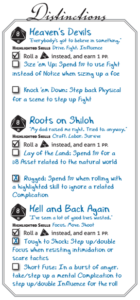 But my favorite method personally is to cook up the Distinctions from scratch. And in every case, it’s a lot of fun to rename your Distinctions once you have a better handle on what you use them for – sometimes you might even get some input from your other players after a session or two of playing together. One of my players changed his Sly Devil Distinction to Finger Guns, because that phrase came up every single time the Distinction did.
But my favorite method personally is to cook up the Distinctions from scratch. And in every case, it’s a lot of fun to rename your Distinctions once you have a better handle on what you use them for – sometimes you might even get some input from your other players after a session or two of playing together. One of my players changed his Sly Devil Distinction to Finger Guns, because that phrase came up every single time the Distinction did.
Jim’s first Distinction is going to be Heaven’s Devils, his old platoon from during the Guild Wars. This has a lot of weight, story-wise – it gives him allies and enemies, and good reasons to have certain training and resources. Mechanically though, it’s just a renamed copy of Scary Lieutenant from the Core book. In the same vein, he picks up the Farmer Distinction, but renames it Roots on Shiloh, representing his background before enlistment.
For the third Distinction, we’re shaking things up just a little. With memories of capture and torture, Plagued By Nightmares seems appropriate – it’s going to keep its Triggers when it becomes Hell and Back Again, but we’re massaging the Highlighted Skills to better fit Raynor, and to eliminate overlap. Now, I actually suggest this step to pretty much every player – it might feel power-gamey, but having a couple extra d6s scattered around really rounds out a character. So feel free to squeeze every little skill point out of your Highlighted Skills as possible. Just make sure you and your GM are on the same page about the skills being appropriate for your Distinction!
You’ll notice a couple of these Triggers have filled in check boxes – a starting character has access to two (above and beyond the automatic one where you trade your strong d8 for a d4 and a Plot Point) additional Triggers, with advancement options to unlock more. So during play, you cannot use the abilities described in locked Triggers. Now, pay attention – even folks who are familiar with the system! It was clarified in the FAQ (which has disappeared from MWP’s website, but is tucked away in the back of Smuggler’s Guide to the Rim) that you are allowed to switch which Triggers are active between scenes – you just have to maintain the same number of active Triggers. This was… honestly mind-blowing when I found out. So there. That’s a thing you now know.
 I kept talking about Skills, well now we get to pin them down. Again, every time you roll the dice, you grab exactly one of these. They all start at d4 and only go up from there – one die size every time a skill gets Highlighted by a Distinction. And then you get nine more bumps after that (though bumping d4s cost double). As you can see, we’ve made sure to showcase what Raynor’s known for in the first game – driving that Vulture around!
I kept talking about Skills, well now we get to pin them down. Again, every time you roll the dice, you grab exactly one of these. They all start at d4 and only go up from there – one die size every time a skill gets Highlighted by a Distinction. And then you get nine more bumps after that (though bumping d4s cost double). As you can see, we’ve made sure to showcase what Raynor’s known for in the first game – driving that Vulture around!
Speaking of which, you see how there’s written-in text there under Drive? That’s a Specialty. Raynor adds his d10 to a roll no matter what he’s trying to drive, but when he’s behind the stick of a Vulture he gets to throw in an extra d6 on top of that. Specialties don’t come from the skill bumps though – there’s a whole extra set of five points to spend between Specialties and Signature Assets.
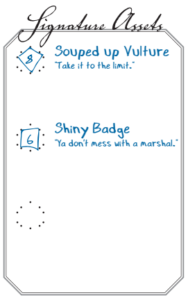 This is the final box on your character sheet that has dice you can grab for rolls (there are more ways to get dice, don’t worry – they’re just found in-play), and they represent… well, just about anything that doesn’t fit as a Distinction or a Skill. It’s commonly a thing like a gun, or a ship, but some of the examples in the book include Academy Blackmail or Sympathetic Townfolk. This gives you a ton of freedom to really push an entertaining and satisfying narrative.
This is the final box on your character sheet that has dice you can grab for rolls (there are more ways to get dice, don’t worry – they’re just found in-play), and they represent… well, just about anything that doesn’t fit as a Distinction or a Skill. It’s commonly a thing like a gun, or a ship, but some of the examples in the book include Academy Blackmail or Sympathetic Townfolk. This gives you a ton of freedom to really push an entertaining and satisfying narrative.
Raynor’s Shiny Badge, for example, isn’t necessarily literally the badge on his coat. It’s the respect and position of being part of the Marshalry on Mar Sara – it might even come in handy if he’s stripped of everything physical and stuck in a cell. Now, the other fun part about Signature Assets is that you can hang Triggers on them, just like with Distinctions. You just don’t get any right away.
And that’s it – Marshal James Raynor, as a starting Firefly RPG character. Come back next week for a brand new character from a whole different setting! PDF links below, including a blank sheet if you want to try this layout for your own games.

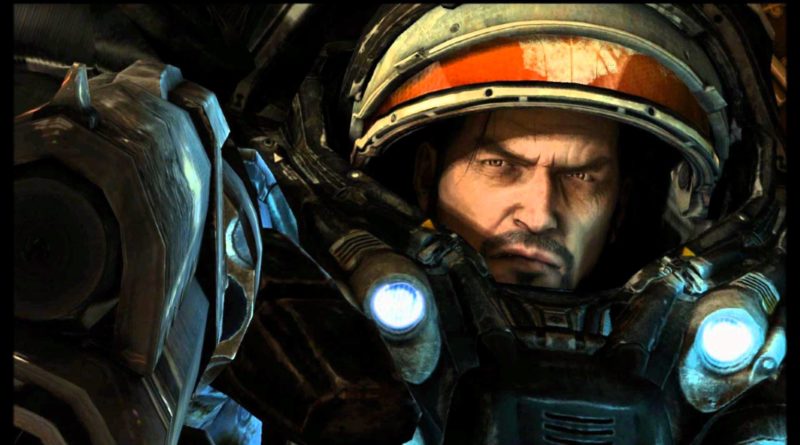
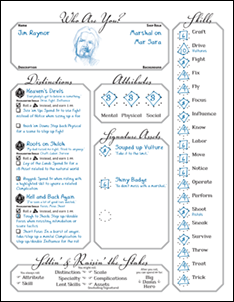
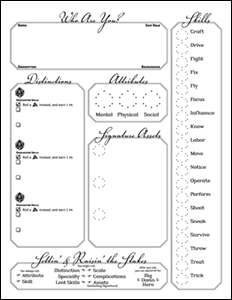
Pingback: Firefly Friday: G’Kar – Dice Monkey
Pingback: Firefly Friday: Starbuck – Dice Monkey